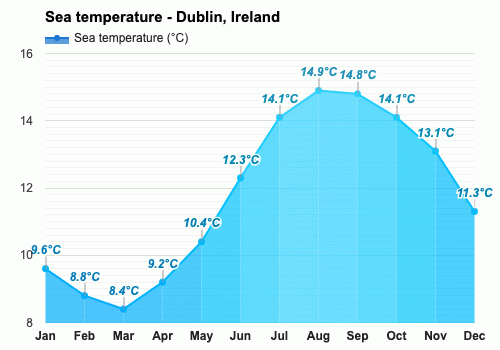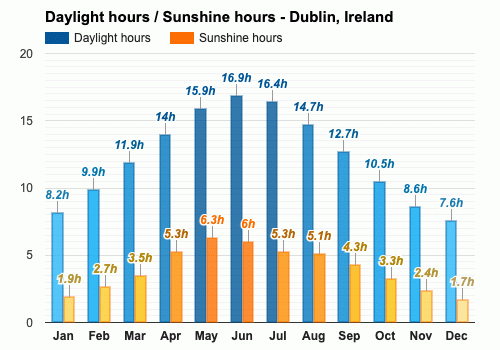Contents
- The climate of Dublin
- The best time to visit Dublin
- The worst time to visit Dublin
- Spring weather in Dublin
- Summer weather in Dublin
- Autumn weather in Dublin
- Winter weather in Dublin
- Weather in January
- Weather in February
- Weather in March
- Weather in April
- Weather in May
- Weather in June
- Weather in July
- Weather in August
- Weather in September
- Weather in October
- Weather in November
- Weather in December
- Frequently asked questions
- Average temperature
- Average rainfall
- Average rainfall days
- Average sea temperature
- Average daylight
- Average sunshine
- Average UV index

Climate and monthly weather forecast
The climate of Dublin
Temperature fluctuations throughout the year are moderate. During the year, high temperatures range from 8.8°C (47.8°F) in January to 20.2°C (68.4°F) in July, while low temperatures vary from 3.9°C (39°F) in January and February to 13.5°C (56.3°F) in July. Rainfall is a constant companion for Dublin, with a monthly average range between 46mm (1.81") in February and 76mm (2.99") in October. The occurrence of precipitation ranges from 9 to 12 days monthly.
Dublin's daylight hours extend from 7.6 hours in December to 16.9 hours in June, bearing a direct impact on the hours of sunshine enjoyed. December offers the fewest hours of sunshine, a stark 1.7 hours, increasing gradually to the maximum 6.3 hours in May. December and January record the lowest UV index, rising up to 6 between June and July.
If water activities pique the interest, it would be valuable to note that the coldest sea temperatures of 8.4°C (47.1°F) occur in March, warming up to 14.9°C (58.8°F) in August before plunging again. The unique pattern that Dublin's weather follows is its consistent precipitation throughout the year, with no distinct dry period.
The best time to visit Dublin
The worst time to visit Dublin
Spring weather in Dublin
Summer weather in Dublin
Autumn weather in Dublin
Winter weather in Dublin
Weather in January
Weather in February
Weather in March
Weather in April
Weather in May
Weather in June
Weather in July
Weather in August
Weather in September
Weather in October
Weather in November
Weather in December
Published by: Weather Atlas | About Us
Data Sources | Weather Forecasting & Climate
Frequently asked questions
What part of the year is the coldest in Dublin?
How much does it rain in Dublin?
When is the lowest UV index in Dublin?
What is the driest month in Dublin?
When is the sea coldest in Dublin?
What month has the most sunshine in Dublin?
When are the longest days in Dublin?
What is the month with the highest UV index in Dublin?
What month is the hottest in Dublin?
When is the sea warmest in Dublin?
What is the rainiest month in Dublin?
When is Daylight Saving Time (DST) in Dublin?
What is the month with the shortest days in Dublin?
What is the month with the least sunshine in Dublin?

Average temperature
Dublin, Ireland
The warmest month (with the highest average high temperature) is July (20.2°C).
The month with the lowest average high temperature is January (8.8°C).
The month with the highest average low temperature is July (13.5°C).
The coldest months (with the lowest average low temperature) are January and February (3.9°C).

Average rainfall
Dublin, Ireland
- Average rainfall in January:
62.6mm - Average rainfall in February:
46.1mm - Average rainfall in March:
51.8mm - Average rainfall in April:
50.2mm - Average rainfall in May:
57.9mm - Average rainfall in June:
59.2mm
- Average rainfall in July:
50.5mm - Average rainfall in August:
65.3mm - Average rainfall in September:
56.7mm - Average rainfall in October:
76mm - Average rainfall in November:
69.4mm - Average rainfall in December:
68.7mm
The wettest month (with the highest rainfall) is October (76mm).
The driest month (with the least rainfall) is February (46.1mm).

Average rainfall days
Dublin, Ireland
- Average rainfall days in January:
12 days - Average rainfall days in February:
10 days - Average rainfall days in March:
11 days - Average rainfall days in April:
11 days - Average rainfall days in May:
11 days - Average rainfall days in June:
9 days
- Average rainfall days in July:
10 days - Average rainfall days in August:
10 days - Average rainfall days in September:
9 days - Average rainfall days in October:
12 days - Average rainfall days in November:
11 days - Average rainfall days in December:
12 days
The months with the highest number of rainy days are January, October and December (12 days).
The months with the least rainy days are June and September (9 days).

Average sea temperature
Dublin, Ireland
The best month for swimming (with the highest average sea temperature) is August (14.9°C).
The coldest month (with the lowest average sea temperature) is March (8.4°C).

Average daylight / Average sunshine
Dublin, Ireland
- Average daylight in January:
8h and 1min - Average daylight in February:
9h and 5min - Average daylight in March:
11h and 5min - Average daylight in April:
14h and 0min - Average daylight in May:
15h and 5min - Average daylight in June:
16h and 5min
- Average daylight in July:
16h and 2min - Average daylight in August:
14h and 4min - Average daylight in September:
12h and 4min - Average daylight in October:
10h and 4min - Average daylight in November:
8h and 4min - Average daylight in December:
7h and 4min
The month with the longest days is June (Average daylight: 16h and 54min).
The month with the shortest days is December (Average daylight: 7h and 36min).
- Average sunshine in January:
1h and 5min - Average sunshine in February:
2h and 4min - Average sunshine in March:
3h and 3min - Average sunshine in April:
5h and 2min - Average sunshine in May:
6h and 2min - Average sunshine in June:
6h and 0min
- Average sunshine in July:
5h and 2min - Average sunshine in August:
5h and 1min - Average sunshine in September:
4h and 2min - Average sunshine in October:
3h and 2min - Average sunshine in November:
2h and 2min - Average sunshine in December:
1h and 4min
The month with the most sunshine is May (Average sunshine: 6h and 18min).
The month with the least sunshine is December (Average sunshine: 1h and 42min).

Average UV index
Dublin, Ireland
The months with the highest UV index are June and July (UV index 6).
The months with the lowest UV index are January and December (UV index 0).


